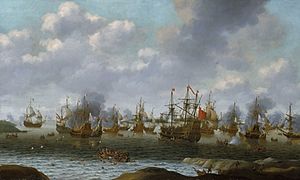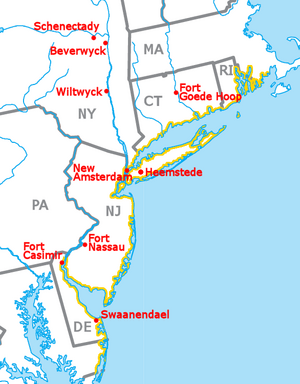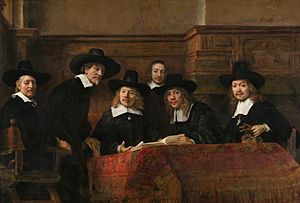Treaty of Breda (1667) facts for kids

Contemporary engraving of the signing of the peace at Breda Castle
|
|
| Context | England, the Dutch Republic, France and Denmark–Norway end the Second Anglo-Dutch War |
|---|---|
| Signed | 31 July 1667 |
| Location | Breda |
| Effective | 24 August 1667 |
| Mediators | |
| Negotiators | |
| Signatories | |
| Parties | |
The Peace of Breda, also known as the Treaty of Breda, was signed on July 31, 1667. This important agreement took place in the Dutch city of Breda. It was actually three separate treaties. These treaties ended the Second Anglo-Dutch War. They were signed between England and its opponents: the Dutch Republic, France, and Denmark–Norway. There was also a special trade agreement between England and the Dutch.
Talks for peace had been going on since late 1666. But they were very slow. Both sides wanted to get the best deal for themselves. Things changed quickly in May 1667. France invaded the Spanish Netherlands. The Dutch saw this as a much bigger problem. At the same time, people in England were tired of the war. This feeling grew after the Dutch attacked the English navy in June, known as the Raid on the Medway. These events made everyone want to agree to peace terms fast.
Before 1667, England and the Dutch Republic often fought over trade. The treaty didn't completely stop these arguments. However, tensions between them became much lower. This made it possible for them to form the Triple Alliance in 1668. This alliance included the Dutch Republic, England, and Sweden. Except for a short time during the Third Anglo-Dutch War (1672-1674), the Treaty of Breda started a long alliance between England and the Dutch. This alliance lasted for about 100 years.
Why the War Started

The Second Anglo-Dutch War happened because of arguments over trade. King Charles II of England wanted to make more money from trade. This would help him rely less on the English Parliament. In 1660, he and his brother James started the Royal African Company (RAC). This company competed with the Dutch in West Africa. Many important politicians invested in the RAC. This linked the company's success to government decisions.
The spice trade in Asia brought huge profits. The Dutch East India Company, called VOC, controlled this trade. They worked hard to keep their monopoly. By 1663, they had removed most other traders. This included the Portuguese. The only place left was the nutmeg plantations on Run. British traders had set up these plantations in 1616. But the VOC kicked them out in 1620. When the English came back to Run in 1664, the Dutch removed them again. This time, they destroyed the plantations.
There was also a fight over trade in the Atlantic Ocean. The Dutch West-Indische Compagnie, or WIC, competed with other countries. These included Spain, Denmark, Sweden, Portugal, and England. Sugar farms in the Americas used slaves from Africa. These slaves were fed by colonies in North America. This led to conflicts in all three areas. In August 1664, the English took over New Netherland. They renamed it New York. Then, they attacked WIC slave trade posts in modern Ghana. The Dutch sent their navy to get them back. This made the RAC lose a lot of money. Its investors thought war was the best way to get their money back.
France and the Dutch had a treaty from April 1662. But King Louis XIV of France stayed neutral at first. France and the Dutch had different economic goals. Especially about the Spanish Netherlands. The 1648 Peace of Münster closed the Scheldt river mouth. This gave Amsterdam control over trade in North-West Europe. Louis XIV believed the Spanish Netherlands belonged to him. He was married to Maria Theresa of Spain. He hoped to get the land peacefully. But talks with the Dutch always failed. By 1663, he decided he would need to use his army.

In early 1665, England made an alliance with Sweden against the Dutch. The Dutch suffered a big defeat at Lowestoft in June. Then, an army from Münster invaded. Louis XIV reacted by using his 1662 treaty with the Dutch. He thought this would make it harder for the Dutch to stop him from taking the Spanish Netherlands. He also paid Sweden to stay neutral. And he convinced Denmark–Norway to join the war. Danish help saved the Dutch merchant ships at the Battle of Vågen in August. However, this was due to a misunderstanding. King Frederick III of Denmark had secretly agreed to help the English. He wanted to capture the Dutch fleet and share the profits. But his orders arrived too late.
By late 1666, King Charles II of England was running out of money. This was mainly because he refused to call Parliament. English trade was also badly hurt by the war and other problems. But the Dutch economy had mostly recovered. Their public debt was lower in 1667 than in 1652. Still, naval wars were very expensive. Even for the rich markets of Amsterdam, paying for it was hard. Both sides wanted peace. The Dutch had little to gain from continuing the war. They also faced challenges from other countries. Denmark was unhappy about trade rules from 1647. The WIC taking Danish ships was also a problem. In early 1667, Denmark, Sweden, and France put taxes on Dutch goods. This hurt the Baltic grain trade.
In October 1666, Charles II started talking with the States-General of the Netherlands. He pretended to be arranging the return of Vice-Admiral William Berkeley's body. Berkeley had died in the Four Days' Battle. Charles invited the Dutch to talks in London. He also dropped some earlier demands. These included making his nephew William of Orange the stadtholder. He also stopped asking for money for damages. And he no longer demanded the return of Run or a special trade deal in India. The Dutch refused to talk without France. For land claims, they offered to keep things as they were. Or they offered to go back to the situation before the war. The English clearly would not accept the second option.
It's not clear if Charles's offer was truly honest. His envoy in Paris, the Earl of St Albans, was secretly talking about an Anglo-French alliance. Louis XIV agreed to make the Dutch accept English demands. In return, he wanted to be free to act in the Spanish Netherlands. By April 1667, diplomats thought a deal was very close. When talks finally began, the English felt they were in a very strong position.
Peace Talks Begin

Grand Pensionary Johan de Witt and the States of Holland did not want to negotiate in The Hague. This town was controlled by the Orangist group. This group was against De Witt. Louis XIV supported De Witt. He saw the Orangists as English agents. The States of Zeeland, Gelderland, Groningen, Overijssel and Friesland were angry about the delay. They threatened to stop paying for a war. They said it was "continued only by Holland's obstinacy."
The countries finally agreed to meet in Breda. But France was preparing for war. This made the Orangists accuse De Witt of delaying talks on purpose. They said he wanted to let Louis XIV take over the Spanish Netherlands. This put De Witt under pressure to reach an agreement. The pressure grew after France and Portugal made an alliance against Spain in March.
Being a mediator in peace talks was a sign of importance. It also allowed countries to build relationships. Both Louis XIV and Leopold I of the Holy Roman Empire wanted to be the mediator. So, they agreed to use Swedish diplomats instead. Sweden was important for trade in the Baltic Sea. They traded grain, iron, and shipping supplies. The Swedes hoped to remove trade rules that the Dutch had forced on them in 1656. This was the Treaty of Elbing. They also wanted to end the Dutch alliance with Denmark. Göran Fleming was in Breda for the talks. Peter Coyet was in The Hague. Coyet died on June 8. Count Dohna replaced him. Dohna was told to try for a Swedish-English-French alliance if the Breda talks failed.
The States General chose eight delegates. But only those from Holland, Zeeland, and Friesland were there. Two of the three were Orangists. They were Zeelandic Pensionary Pieter de Huybert and Friesland's van Jongestall. The delegate from Holland, Van Beverningh, was part of De Witt's States Party. England's main negotiators were Denzil Holles. He was the Ambassador to France. The other was Henry Coventry, the Ambassador to Sweden.
On May 24, Louis XIV started the War of Devolution. French troops quickly took over much of the Spanish Netherlands and Franche-Comté. To focus on this war, Spain needed to end the long Portuguese Restoration War. On May 27, England and Spain signed the Treaty of Madrid. This officially ended the 1654 to 1660 war. In return for trade benefits, England agreed to help with peace talks with Portugal.
French expansion was a threat to the Dutch economy. So, ending the Anglo-Dutch War became very urgent. Louis XIV promised to make the Dutch agree to England's demands. Because of this, the English asked for even more. Van Beverningh told De Witt that a big military win was needed. This would improve their bargaining power. Charles II gave them an opportunity. He had stopped using most of the Royal Navy in late 1666 to save money. The Dutch took full advantage in June 1667 with the Medway Raid. This attack didn't have a huge military impact. But it was a big embarrassment for Charles. He never forgot it.
Holles and Coventry first thought this would make talks longer. But an alliance against France was needed. Spain threatened to stop the Madrid treaty. Leopold I supported Spain. These issues, along with war losses and the Great Fire of London, put pressure on England. Clarendon told Holles to agree to terms. He wanted to "calm people's minds" and "free the king from a burden...he is finding hard to bear."
What the Treaty Said

Article 1 of the treaty set up a limited military alliance. It said that fleets or single ships sailing together must defend each other. This was against any third country. Article 3 used the rule of uti possidetis. This means "what you have, you hold." The date for this rule was May 20. The Dutch got back Surinam, which is now part of modern Suriname. The English kept New Netherland. New Netherland was later divided into several colonies. These included New York, New Jersey, Pennsylvania, Massachusetts, Connecticut, and Delaware.
Articles 4 to 8 applied the same rule to lost goods or ships. This included things lost before the war. No payments for damages could be made. No punishments could be given. All existing Letters of Marque (permits to attack enemy ships) were canceled. To give time for these rules to be announced, Article 7 changed the enforcement dates. It was September 5 for the English Channel and the North Sea. October 5 for other European seas. November 2 for the African coast north of the Equator. And April 24, 1668, for the rest of the world.
Article 10 said all prisoners should be exchanged without payment. But the Dutch later asked for money for their living costs. The English saw this as the same thing as asking for ransom. After their failed attempt to take power in 1666, many Orangists went to England. English and Scottish rebels went to the Dutch Republic. In Articles 13 and 17, both sides promised not to protect each other's rebels. In a secret part of the treaty, the Dutch agreed to hand over people who had voted to execute Charles I in 1649. But in reality, these rules were ignored.
A separate treaty changed the Navigation Acts. Goods moved along the Rhine or Scheldt rivers to Amsterdam could be carried by Dutch ships to England. They would not have to pay extra taxes. England also agreed to the rule "free ships make free goods." This meant the Royal Navy could not stop Dutch ships during wars if the Dutch were neutral. These terms were just the first step. A final version was signed on February 17, 1668.
The treaties with Denmark and France also gave up claims for lost goods. England returned the French lands of Cayenne and Acadia. These were captured in 1667 and 1654. But the exact borders were not clear. The handover was delayed until 1670. England got back Montserrat and Antigua. The Caribbean island of Saint Kitts was divided between England and France. After the treaties were signed on July 31, they were sent to each country for approval. This process was finished by August 24. Public celebrations then took place in Breda.
What Happened Next

By trading New Netherland for Run, the Treaty of Breda removed two big reasons for fighting. This lowered tensions between England and the Dutch. It also made way for the 1668 Triple Alliance. This alliance was between the Dutch Republic, Sweden, and England. People often say this alliance forced France to give back most of the land they gained. This happened at Aix-la-Chapelle. But the terms had already been agreed by Louis XIV and Leopold I in January 1668. In the long run, Breda was the point when England and the Dutch started seeing France as a bigger threat. King Charles II wanted an alliance with France. This led to the 1670 Secret Treaty of Dover. But the general trend was against him. Support for making the English navy strong again helped in the Third Anglo-Dutch War. But this support ended once the navy was powerful enough.
The treaty disappointed the Orangists. It did not bring back the House of Orange to power. It also did not allow exiles to return home, as Charles had promised. Zeeland and Friesland wanted William to be made Captain-General of the Dutch States Army. This was because France was advancing. The States of Holland responded on August 5 with the Perpetual Edict. This law ended the position of Stadholder of Holland. Another rule said that no army or navy leader could also be a stadtholder of another province. The army was seen as a power base for the Orangists. So, money spent on it was kept very low. This had terrible effects in 1672.
Breda was also a success for Sweden. They used their role as mediators to improve trade rules. They broke the Dutch-Danish agreement. And they joined the Triple Alliance. Spain got back Franche-Comté and most of the Spanish Netherlands. More importantly, the Dutch now saw Spain as a better neighbor than an ambitious France. Overall, the Dutch thought Breda and the new Alliance were a big diplomatic win. The time right after Breda is often called the peak of the Dutch Golden Age.
Sources


